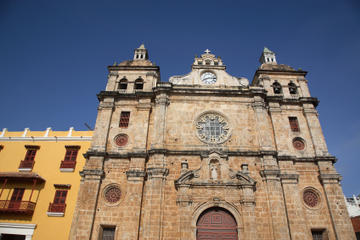Cathedral of San Pedro Claver
TIME : 2016/2/22 10:15:45

Cathedral of San Pedro Claver
Cartagena’s Catedral de San Pedro Claver, so close to the sea wall, seems unduly imposing for such a sanctified site. Begun in 1575, when this was a very rough neighborhood, its unfinished fortifications were destroyed in 1586 during a tiff with Sir Francis Drake and his pirate crew, and rebuilt by 1602.
Its namesake, San Pedro Claver Corberó, did not arrive until 1610. The Spanish-born priest arrived in Cartagena, then a slave-trading hub, as a novice priest. Horrified by the treatment of African captives, sold to a motley crew of middlemen on what’s now Plaza de los Coches, the young man became an activist, writing in his diary, “Pedro Claver, slave of the slaves forever (3 April 1622).”
Pedro would not only baptize newly enslaved arrivals right in the cathedral’s courtyard well (which was already controversial), but he would then explain to the newly saved that they deserved all the rights held by other Christian citizens of the Spanish Empire. This didn’t go over well with their new “owners,” not to mention most of his fellow Jesuits. The Vatican, already officially (if not actively) against slavery, would go on to canonize him in 1888.
The saint’s remains are preserved in the illuminated glass coffin in the altar, and bring in pilgrims that have included Pope John Paul II. The cavernous interior’s arches and columns, hewn from the same pale stone as the sea walls, seem infused with light. The main wooden altar, though not as heavy with gold gilt and precious stones as some, is considered one of Colombia’s most beautiful. The detailed stained glass is also exceptional. Most signage is in Spanish, but some of the tour guides hanging around out front can give you the basic information in English and other languages.
